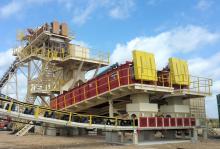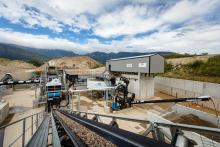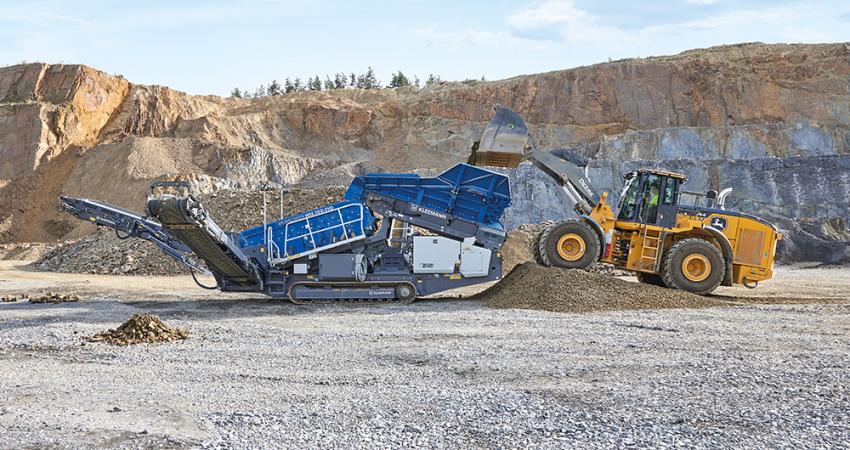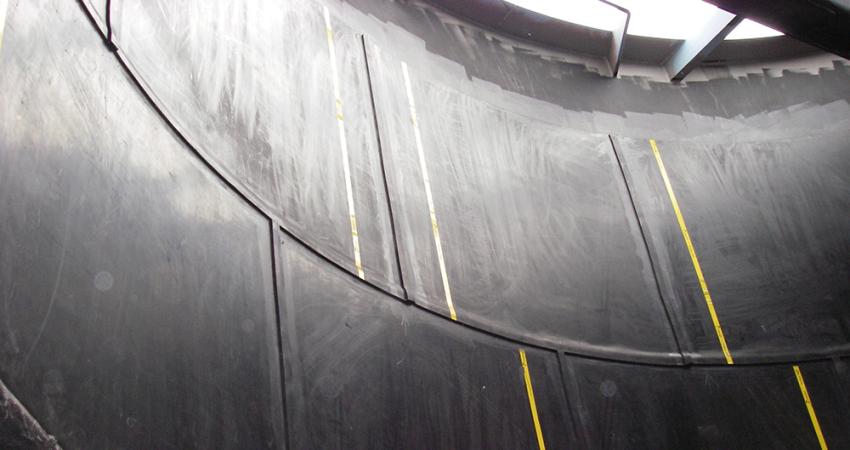
CDE has unveiled the largest version yet of its Combo all-in-one wet processing and water management solution. The new globally available Combo X900 features an increased capacity of 500-tonnes per hour.
Speaking at the CONEXPO-CON/AGG 2020 exhibition in Las Vegas, USA (10-13 March), Kevin Vallelly, director of engineering at CDE, said the new plant has been engineered specifically for materials processors in the Americas. “With our new Combo X900, we’ve doubled its capacity and created a next-gen solution for materials processors across North America and Latin America,” he added.
CDE launched the first version of the Combo plant at bauma 2019. CDE group managing director Tony Convery said the company has now sold over 2,000 plants globally and claimed it is the largest wet processing plant provider in the world.
Vallelly said that 15-20% of each Combo plant is customised to meet the requirements of the specific customer.
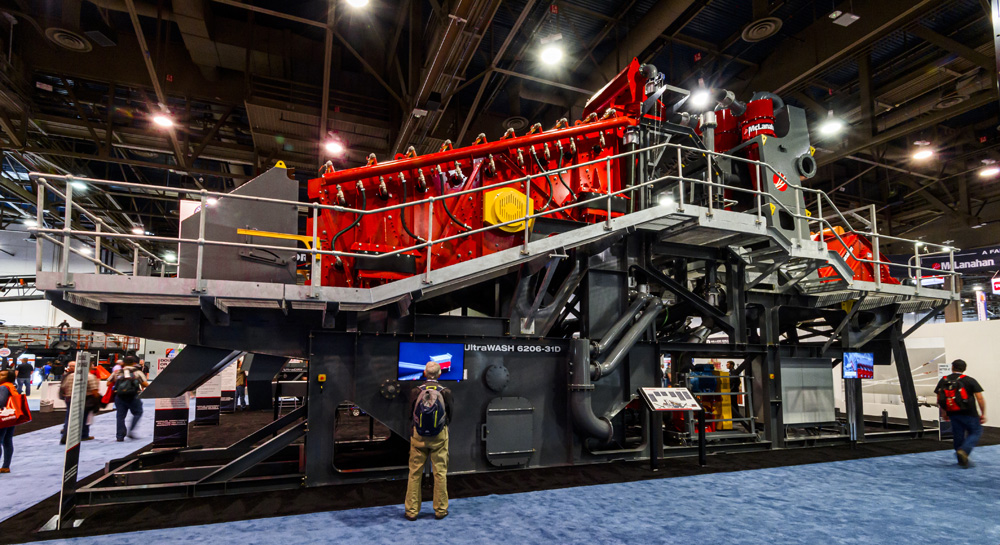
He added that the Combo X900 can process 500 tonnes per hour (tph) of feed material. This includes natural sand and crushed rock, containing unwanted clay, silt and other organic contaminants to extract quality in-spec washed and graded sand products that are market-ready straight from the belts.
As well as its increased capacity, the control cabin of the new X900 has been repositioned to sit on top of the water tank, a design decision Vallelly says is directly influenced by the North and Latin American markets.
“In these regions, plant and machinery are subject to major temperature extremes and fluctuations,” he said.
“By positioning the control cabin on top of the water tank we’re able to better protect the operational heart of the plant and offer a solution that can be adopted throughout both North America and Latin America where high and low temperature extremes are recorded.”
CDE says that, while traditional washing systems typically have a separate standalone water tank, the new Combo X900 has integrated this into the design of the AquaCycle thickener tank. It states that this results in a peripheral wall for water storage, which has significantly reduced the overall footprint.
The Northern Irish company says that this provides customers with almost total independence of water supply and minimises the requirements for costly site engineering due to its significantly smaller footprint which is, on average, 30% smaller than other traditional wash plant set-ups.
“Traditional washing systems would typically consume up to 15 times more water than that required for the Combo X900,” said Vallelly.
The X900 enables materials processors to wash more than 500 tph with only 800 gpm (gallons per minute) - about the same amount of water that would be required to wash a truck, according to CDE.
McLanahan has launched its new UltraDRY dewatering screen that can be added to a new or existing system and is claimed to create a drier, ready-to-sell product.
The US company says customers can achieve moisture content as low as 7% by adding a McLanahan dewatering screen to the end of their screw washer. McLanahan adds that this creates a drier product that is easier to sell and allows better site stockpile management with a shorter inventory cycle, making the customer’s site more efficient.
The Ultra line focuses on a set of standardised units that can be containerised for shipping and supplied quickly.
McLanahan says that its dewatering screens that are part of the UltraDRY system have a high G-force, creating a deeper bed depth, a drier product and with more product processed.
Drive motors on the UltraDRY are oriented to ensure that screens do not need a brake or a VFD (variable frequency drive) to stop the side motion of the screen. Additionally, it can come equipped with a divided deck design so that two separate products can be made on the same screen.
A slurry pump can be added when pairing the UltraDRY with a screw washer to divert the screen’s underflow water back to the screw’s feedwell. McLanahan says this location is ideal for water placement as it limits the system’s water usage and allows material at the top of the screw to stay cleaner and drier. Also available is an optional spray bar, designed to allow operators to scrub away any remaining debris and put the final touches to their product.
Kolberg-Pioneer Inc. (KPI) has partnered with Tecnoidea Impianti to offer water clarification systems in North America.
The clarification systems accelerate the process of filtering fines from dirty water for reuse in the processing plant. These systems are designed to eliminate the need for large and expensive settling ponds by recovering up to 95% of the water that flows to the clarification system. This allows producers to use significantly less water in their system.
“Water clarification systems save producers time and money associated with building, using and maintaining settling ponds. This partnership with Tecnoidea Impianti will allow us to continue to offer a one-source solution for our customers,” said Brett Casanova, washing and classifying product manager for KPI.
The water clarification systems will include flocculation preparation units, static vertical settling tanks, thickened sludge tanks, side and overhead beam plate presses and other accessory components.
At CONEXPO-CON/AGG 2020, Terex Washing Systems (TWS) showcased its Terex FM UltraFines plant, described as a crucial step in efficient management and recovery of ultra-fines material from wastewater streams, produced from washing processes.
The ultra-fines recovery unit can process up to 450m³ per hour of slurry, recovering material as low as 40 microns, thus reducing the volume of solids reporting to storage ponds or water treatment plant. Bringing together a centrifugal pump, a hydrocyclone cluster and a high-frequency dewatering screen on one chassis, the TWS FM UltraFines also boasts an innovatively designed conical tank and anti-turbulence system, which is essential in the process of ultra-fines recovery.
MEKA Global (MEKA) showcased the most recent addition to its compact plant line, the MCSP 1-150, at CONEXPO-CON/AGG 2020. The unit has since been delivered to its final customer in the U.S. and was due to be operational from early April.
The MCSP 1-150 plant is the first MEKA compact plant sold in the US market, with the sale said to have followed a lengthy purchase process. Every technical aspect was dissected and discussed thoroughly, with initial discussions focusing on areas including the plant’s components.
Each major component of MEKA compact plant is said by the Turkish company to be chosen in order to offer customers a plant capable of supplying predictable and reliable performance during its working life.
A company spokesperson said: “MEKA has an extensive knowledge base over the performance of its compact plant and we were able to present [to the U.S. customer] final product scenarios over a wide range of product feed distributions. Optional spray bars were added to correct a few fractions which proved to be out of ASTM C33 Specifications.
“Predicting performance on commissioning day when all the equipment is ready, and every parameter is under control is usually the easier side [of a sale]. Keeping the same performance several months or even years later is another challenge. The natural rubber liners in the MCSP 1-150 plant’s hydrocyclone and pump are among the longest-wearing parts available in the industry. Carefully studying the merits of each case, we make slight changes to our plant to provide maximum wear life. How to ensure the best final product particle shape, particle size and mineral composition of the feed are important parts of our plant design process. We use different wear protectors including AR steel, UHMWPE, polyurethane, and natural rubber depending on the wear area in a MEKA compact plant. All these different wear parts options allow us to provide reliable performance over a longer time for each application.”
MEKA says that the MCSP 1-150 plant’s self-levelling sump tank with low-water sensor, overflow recirculation, high-volume sump tank, and oversized vibrators with bearing lifetime exceeding 20,000 hours all contribute to its long-term reliable performance with minimal supervision.
MEKA said that its range of compact plant displayed at CONEXPO-CON/AGG 2020 received great recognition from the firm’s U.S. distributors. The company spokesperson added: “This recognition has resulted in a new purchase order for a 1250m³ per hour dredge dewatering system to give 450 tonnes per hour of product to be processed as frac sand. Discussions for another three units are continuing.”
MEKA’s sand washing equipment line also includes attrition scrubbing plant, fine material washers, coarse material washers, log washers and water recycling equipment. The range is said to offer a plant solution for most challenging applications.


